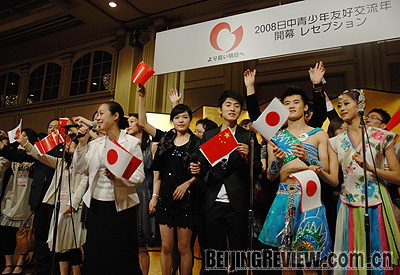|

FRIENDS ARE FOREVER: Youths from China and Japan participate in the opening ceremony of the 2008 China-Japan Friendly Exchange Year of the Youth in Tokyo, on May 8
By all accounts Chinese President Hu Jintao's visit to Japan in May was a success. Old connections were renewed, and the experience gained and lessons learned in the past few years combined to see the signing of a joint statement between China and Japan that will guide their bilateral relationship to a new level. That's good news not only for both countries and the region, but also for the world.
Mission accomplished

COMMUNICATION IS KEY: Visiting Chinese President Hu Jintao makes a speech at the Waseda University on May 8 in Tokyo
President Hu's Japanese tour was a busy affair. In all he took part in 55 activities, meeting with Japanese Emperor Akihito, Japanese Prime Minister Yasuo Fukuda, chairmen of the Japanese parliament, leaders of Japan's main political parties, leaders of economic circles, some old Japanese friends of China, people from cultural organizations, young Japanese and ordinary Japanese citizens.
The visit got good reviews among the Japanese people, said Feng Zhaokui, a senior research fellow on Japan studies from the Chinese Academy of Social Sciences (CASS). "Even some Japanese media usually cold toward China changed their tone after the visit," he told Beijing Review, adding that Japanese who are friendly toward China were even more delighted now.
Xinhua News Agency quoted some comments from mainstream Japanese media. Japan's biggest television station NHK said that the visit showed the importance China attaches to its relations with Japan, because this was Hu's first state visit in his second term as Chinese president. Kyodo News said that the two countries realized that they are important members of the international community and this has prompted the setting up of a strategic reciprocal partnership that can resist international challenges.
China was equally satisfied with the visit. "President Hu's warm-spring visit opened up a new phase for China-Japan strategic and mutually beneficial relations, and was a complete success," Chinese Foreign Minister Yang Jiechi said in a statement posted on the website of the Foreign Ministry. Yang said there were four important aspects of the visit.
First, the visit created a blueprint for the development of Sino-Japanese relations and guiding the development in the right direction. Yang said the newly issued six-point Sino-Japanese joint statement on all-round promotion of their strategic and mutually beneficial relations is important because it will serve to improve bilateral strategic mutual trust, build a framework of developing long-term, stable and healthy bilateral ties, and fully deepen bilateral strategic reciprocal relations. In addition, the two sides set up a mechanism of strengthening communication between the two governments and agreed to cooperate on 70 projects. "Against the background of economic globalization and regional integrity, the Sino-Japanese relationship is of greater significance than ever," Yang said.
Second, the visit led to a deepening cooperation in the trade and economic area, and stabilizing material bases for developing bilateral ties. During the visit, the two sides made progress in cooperation of energy-saving technologies, water pollution treatment and urban construction. They also agreed to push forward cooperation in various fields, including energy, environment, trade, investment, information and communication technology, finance, food and product safety, protection of intellectual property right and business environment. During the Chinese president's visit, the two countries also signed agreements on many projects of trade and economic cooperation, including China importing Japanese rice and the two countries setting up a joint oil refinery venture.
The third was a focus on cultural communication and people-to-people links. President Hu was warmly welcomed by the Japanese people and he met with young people at the opening ceremony of the 2008 China-Japan Friendly Exchange Year of the Youth, which helps to improve Japanese youths' understanding of China. Hu also met with old friends and their families who had made great contributions to bilateral communication.
The fourth was an agreement to improve the common understanding about regional and international affairs, regional integrity and global challenges. The two sides agreed on enhancing cooperation in climate change and environmental protection, which is expected to create new growth points of bilateral trade and economic cooperation, Yang said.
Making the statement
Experts on international studies pointed out that the joint statement the two countries issued during the visit would guide the bilateral relationship in the future. Japanese daily newspaper Asahi Shimbun said on May 8 that the statement reflected the two sides' practical and realistic common understanding, which made peace and friendship their "only choice."
"The two sides will continue to build up mutual understanding and trust, expand mutually beneficial cooperation, make sure that the future development of China-Japan relations conforms to the trend of the world's development, and jointly creates a bright future for the Asia-Pacific region and the world at large," said the joint statement.
Feng said that this meant both sides realized they need to build a bilateral relationship that follows world trends and benefits the world.
He said there are four current world trends: First, peace and development remain the main themes of today's world; second, economic globalization results in many problems, such as the widening gap between the poor and the rich, orderless financial market and anti-globalization sentiment. In the meantime, economic globalization and regional cooperation are marching ahead; third, the world is changing from a unilateral to a multilateral world; and fourth, as the world is facing sharpening regional and global environmental problems, countries should unite to save the globe.
"The points in the joint statement reflect these trends," Feng told Beijing Review.
| 